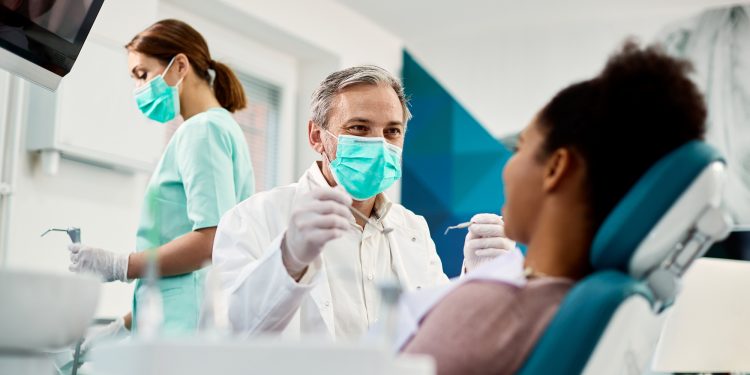A smile transcends languages and profoundly impacts first impressions and self-esteem. It's a subtle yet significant feature that can influence personal and professional relationships. Dental issues could hinder your confidence to smile, which could detrimentally affect your mental health. Misaligned or stained teeth can make smiling a challenge.
With advancements in dental technology, enhancing your smile has become more accessible and less invasive. Non-invasive treatments are an attractive option for those looking to improve their smiles without undergoing major dental procedures. This piece seeks to enlighten a broad readership about the different methods available in non-invasive dental procedures, catering to people from all walks of life.

Understanding Non-Invasive Dental Procedures
Non-invasive dental techniques focus on enhancing your teeth's appearance without significantly changing their structure or resorting to surgical methods. These procedures, encompassing cosmetic dentistry, aim to improve the visual aspects of your smile.
They range from teeth whitening to correcting minor misalignments and reshaping teeth. The essence of these treatments lies in their minimal interference with natural teeth, prioritizing preservation while enhancing aesthetics.
Overview Of Non-Invasive Dental Procedures
Professional Teeth Whitening
Professional teeth whitening can significantly enhance the brightness of your smile. It uses more potent bleaching agents than over-the-counter products, effectively removing deep stains. Regular dental supervision during this process mitigates risks like gum irritation and tooth sensitivity.
In-office whitening often provides noticeable results in a single visit, though some cases may require additional sessions for optimal whitening. Dentists apply protective measures for gums and use customized trays for even application. At-home treatments prescribed by dentists offer convenience with gradual results, using lower-concentration bleaching agents.
Cosmetic Dental Bonding
Dental bonding is a versatile solution for minor cosmetic changes. It involves applying a tooth-colored composite resin to the tooth, which is then shaped and hardened. This technique skillfully fixes teeth gaps, chips, and cracks, enhancing your smile's appearance.
It's a quick process, often completed in one visit, with no anesthesia required. The resin used in bonding can be matched to your natural tooth color, creating a seamless look. However, it's less stain-resistant compared to crowns or veneers.
Invisible Aligners
Invisible aligners like Invisalign offer a discreet way to straighten teeth. Custom-made from clear plastic, they gently shift your teeth into the desired position over time. They're popular among adults and teens seeking less noticeable alternatives to traditional braces.
When you opt for this procedure, you'll receive a series of slightly different aligners to be worn for about two weeks. This method allows easy removal during meals and brushing, promoting better oral hygiene than traditional braces. Yet, commitment to wearing them consistently is crucial for effective treatment.
Gum Contouring
Gum contouring reshapes excess or uneven gum tissue to enhance your smile. This procedure is often sought by those who feel their smile is too “gummy” or their gums overshadow their teeth. It's a quick process, usually painless due to local anesthesia.
Results from gum contouring are immediate and permanent, offering a long-term solution. It's essential to have healthy gums before considering this procedure, as it involves removing small amounts of gum tissue to achieve the desired aesthetic. Nevertheless, considering your dental health and dentist's advice, these treatments might be suitable for specific conditions like gum disease.
Porcelain Veneers
Porcelain veneers can dramatically alter the appearance of your smile. These thin shells are custom-made to cover the front of your teeth, addressing issues like chips, discoloration, or gaps. Veneers are known for their durability and resistance to stains.
The process involves removing a small amount of enamel for a snug fit. While veneers are irreversible, they provide a long-lasting solution, typically lasting 10-15 years with proper care. They mimic the light-reflecting properties of natural teeth, guaranteeing a natural-looking result.
No-Prep Veneers
No-prep veneers are a minimally invasive alternative to traditional veneers. They involve little to no removal of tooth enamel, preserving more of your natural tooth structure. This makes the procedure reversible, a significant advantage for those hesitant about permanent alterations.
These ultra-thin veneers can correct discoloration, chips, and minor misalignments. They're typically applied with minimal discomfort, similar in process to traditional veneers but without extensive enamel removal. But, they might not be ideal for addressing more complex dental conditions.
Choosing The Right Non-Invasive Procedure
Selecting the right non-invasive treatment demands careful thought. Factors like dental health, aesthetic goals, and budget are crucial in this decision. If you need assistance, a dental consultation provides personalized advice, tailoring the treatment to your specific needs.
Think about your long-term goals and maintenance commitment. Some treatments offer quick fixes, while others, like veneers, provide lasting changes. Your dentist will help you navigate the choices, aiding you in making a decision that fits your lifestyle and preferences.
Conclusion
Non-invasive dental procedures testify to modern dentistry's ability to enhance smiles with minimal discomfort and downtime. They provide options with distinct advantages tailored to meet different aesthetic desires and dental conditions. A professional consultation can clarify the best approach for your situation, leading to a confidence-enhancing smile.
























